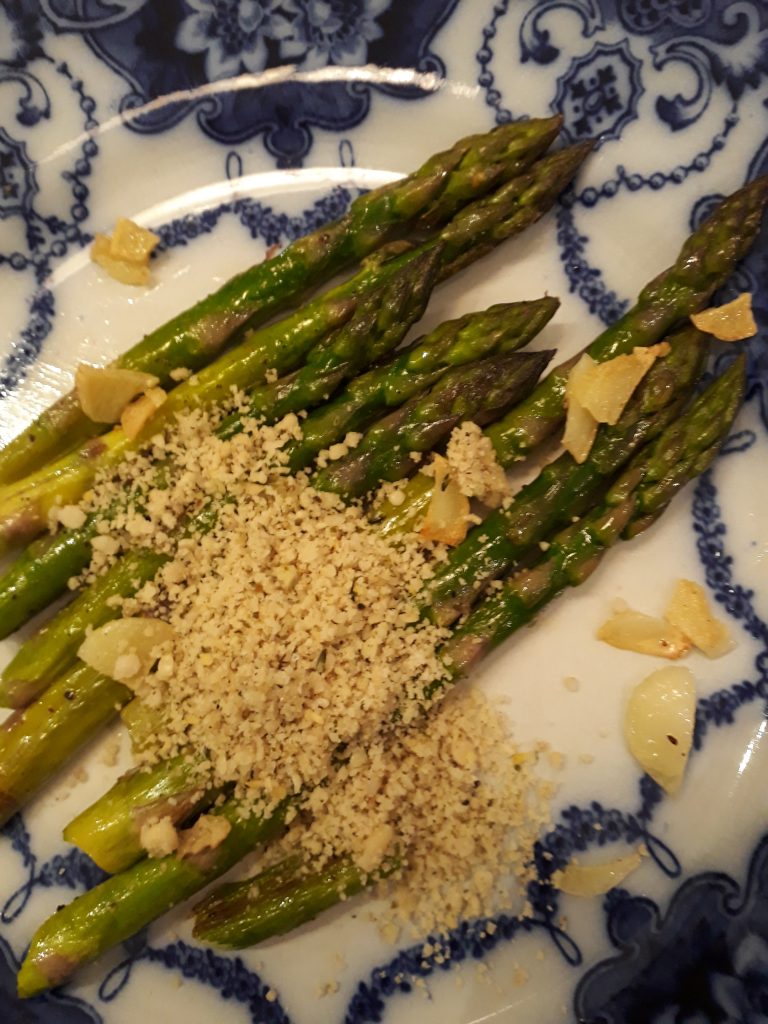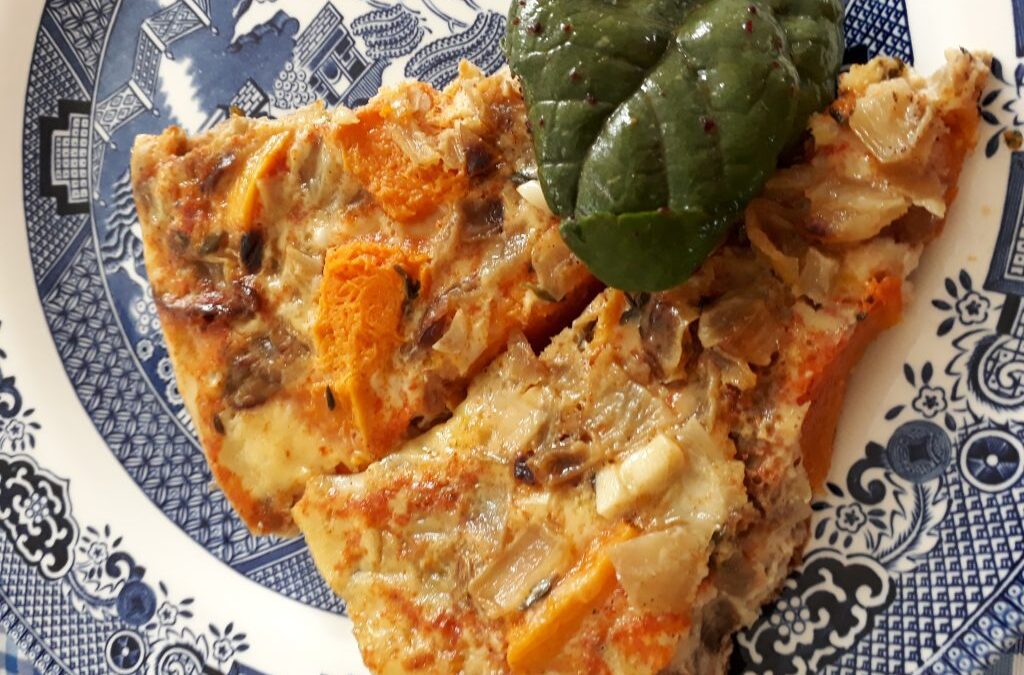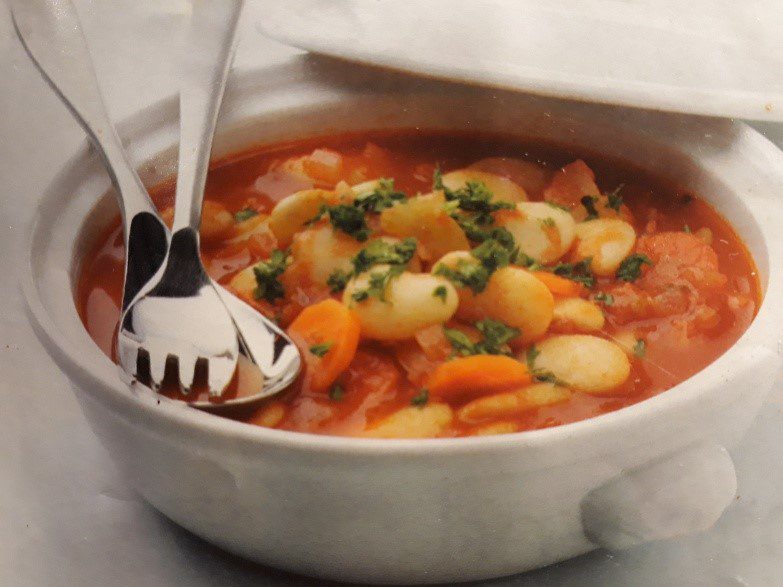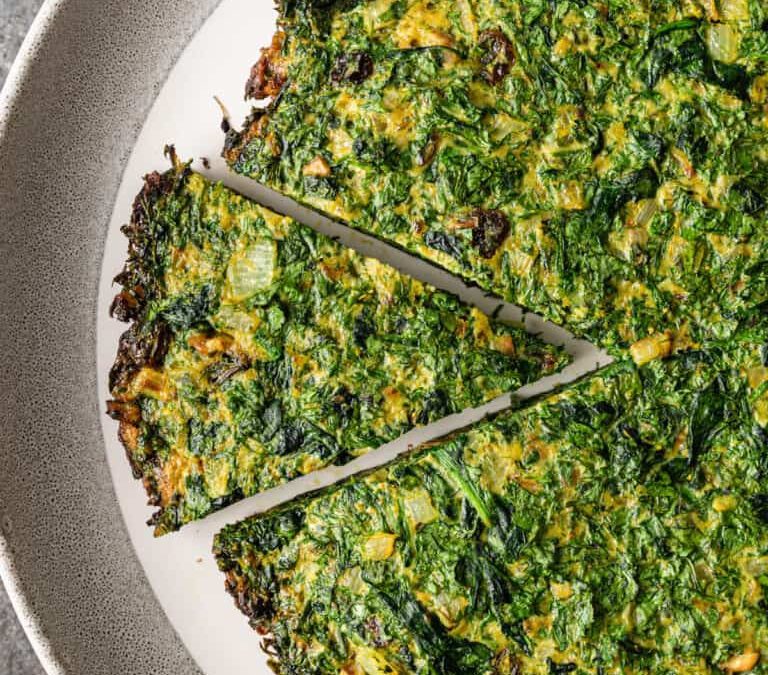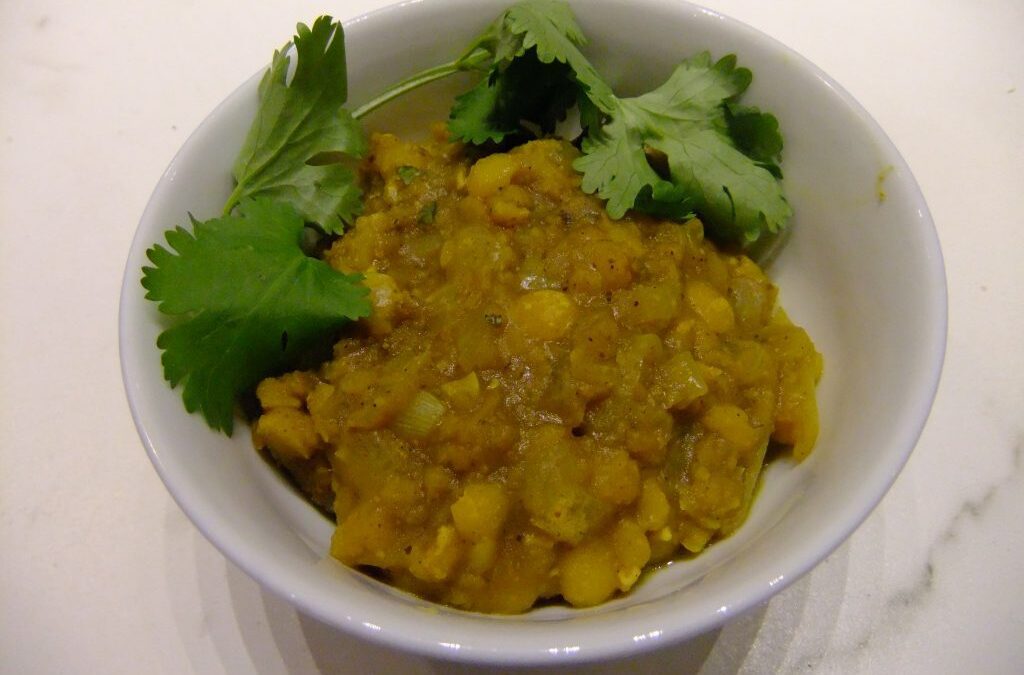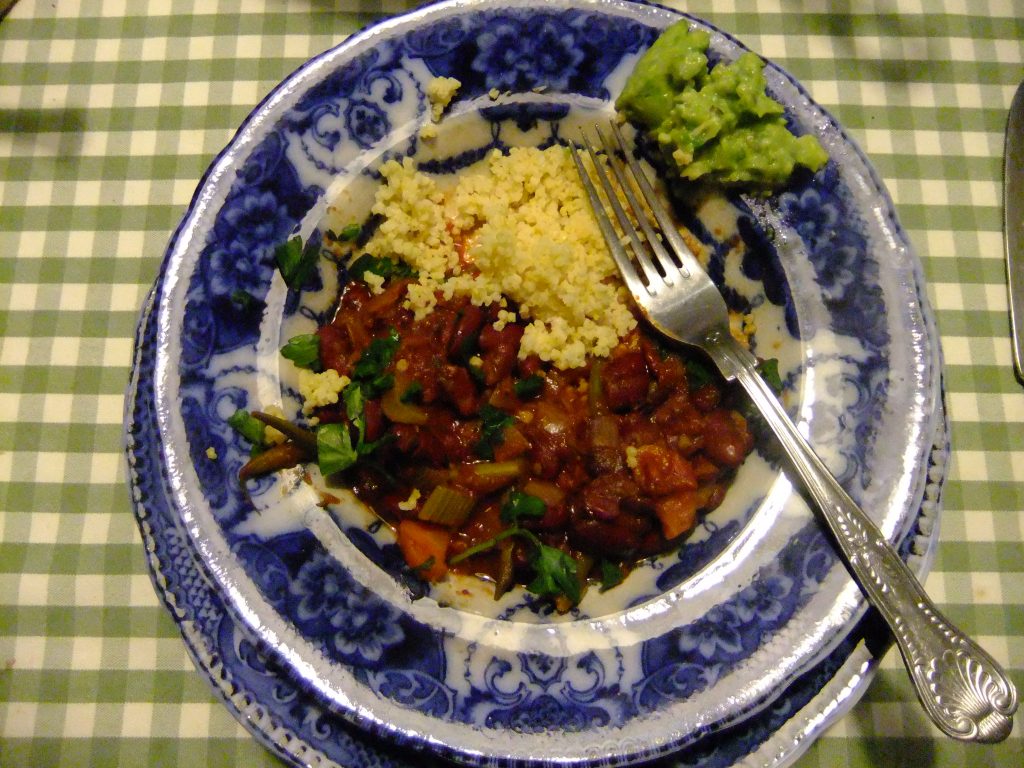
Oct 3, 2021 | Anna's Best Recipes, Sides, starters, soups & snacks
I love this and I’ve made it so many times now I don’t need a recipe. Make it as cauliflower “steaks” or florets (a bit faster).
If you prefer an Indian vibe use a spice blend of 1 level tsp each of ground cumin, coriander and turmeric alongside the pepper and salt.
1 whole cauliflower, green leaves removed
1 heaped tsp ground sumac or sweet paprika
Freshly ground black pepper
Pink (Himalayan) salt
Extra virgin olive oil (about 2-3 tbs)
Roast cauliflower “steaks”
Preheat oven to 215c/200C fan
With the cauliflower standing on its stalk, slice it downwards into 1.5-2cm slices. You’ll get 4-5 good “steaks” and some shards.
Brush the roasting tin with extra virgin olive oil lay the cauliflower slices on top rubbing them around a bit to coat with the oil without breaking them up.
Brush the tops with olive oil, sprinkle with the sumac/paprika, lots of freshly ground black pepper and a generous pinch of salt.
Roast 15-20 mins at 200C. It’s done when the edges are starting to char.
Roast cauliflower florets
Take out central thick stalk from the cauliflower and break into small florets.
Put in the roasting dish, drizzle on extra virgin olive oil, sprinkle on your spices, pepper and salt and toss to coat.
Roast 10-15 mins at 220c/fan 200c.
Its done when the edges are starting to char.
If you feel like a fancier recipe with a delicious middle eastern dressing go to my blog post https://www.annacollins.ie/oven-roasted-cauliflower-green-bean-salad/

May 26, 2021 | Anna's Best Recipes, Cakes, biscuits & bars
I can’t remember the cookbook these come from but my thanks to the amazing Emily and Patrick at Madawaska who produced these gorgeous bites using gluten-free oats. They didn’t last long. If you have the time and like a nuttier flavour, you can toast the oatflakes first like they did. I don’t bother. People really love these and they are super-easy. I did replace the bad-for-your-health margarine in the original recipe for a far healthier virgin coconut oil though.
Using non-dairy milks in these gives a much longer shelf-life in the fridge. The best plant milks have no toxic emulsifiers (carageenen, polysorbate-80, sodium carboxymethylcellulose) and no added sugar.
Makes 36 (enough to feed a small army!)
2½ rounded tbs cocoa powder
¾ cup maple syrup
¼ cup unsweetened non dairy milk (e.g. almond, coconut, hemp)
1/3 tsp vanilla extract (avoid vanilla “essence” unless you are OK eating gluten)
¼ cup virgin coconut oil
1½ cups fine gluten-free oatflakes (you can use normal porridge oatflakes if you eat gluten)
¼ cup no-added-sugar almond or hazelnut butter (if you are in peak health with no autoimmune conditions then no-added-sugar smooth peanut butter is OK to use)
1¾ cups dessicated coconut (divided into 1 cup and ¾ cup)
1. Mix the cocoa and syrup together in a saucepan, add the milk vanilla and coconut oil. Heat gently until liquified and stir to mix well, scraping the sides, being sure not to let it boil or burn. Cool mixture.
2.In a separate bowl combine oats, peanut butter together using your hands. Pour in tht cocoa mixture and add 1 cup coconut. Mix well with your hands.
3.Roll dough into 2.5cm balls. If the mix is too wet you can add more oatmeal or roll the balls into the remaining coconut. They will be somewhat sticky but will harden as they cool. Put on a try and store in the fridge.
Tip:
I wanted to make them stick really well together so added some more oatflakes I had whizzed to a flour in my mini food processor. Oat flour is stickier than oatflakes. I probably didn’t need to do this but liked the result.
Why these are better for you:
Although these contain carbohydrate (sugars) from oats and maple syrup they are healthy when you eat them in moderation. Raw cocoa is full of antioxidants. Virgin coconut oil is a great source of easy to digest medium chain triglycerides that can be burned by your body directly for energy instead of being stored as fat.
Oats contain soluble fibre that feeds beneficial bacteria. Maple syrup is essentially sugar, but it does contain some minerals – unlike refined sugar, which is just empty calories. The protein from peanut butter and the fat from coconut keeps you fuller for longer, reducing the tendency to binge you can get from eating low fat low protein high sugar products.
Cocoa is a spice with antioxidant and anti-inflammatory powers – hurray!!
Like gluten grains, peanuts are high in “lectins” – proteins that are hard to digest and can overstimulate your immune system if you have an autoimmune condition (e.g. hypothyroidism, Crohn’s, ulcerative colitis, arthritis),

Mar 12, 2021 | Anna's Best Recipes, Sides, starters, soups & snacks
I LOVE this and it takes less than 10 minutes to cook. Have it as a side, or sprinkle with my vegan Parmesan (recipe on blog) or grated Parmesan and enjoy as a starter. Asparagus is contains prebiotic fibre, which feeds beneficial bacteria in your gut. You can make this even simpler if you want, by simply steaming the asparagus, then serving sprinkled with extra virgin olive oil etc. You can also steam asparagus, cut it up, cool and pimp up a lunchtime salad with it.
For 2
1 large bunch green asparagus
1 tbs extra virgin olive oil (EVOO)
Freshly ground black pepper
Optional: Parmesan or my vegan Parmesan to sprinkle
1. Rinse asparagus. Then snap off the thick fibrous ends (you can keep to make veg stock if you like).
2. Heat a frying pan on medium heat, add about 2 dsp EVOO (you don’t have to be exact), the same amount of water, asparagus spears and a good grind of pepper.
3. Cover with a lid or plate and cook for around 3-4 minutes until the colour changes to bright green and soft enough for your taste.
4. Divide between 2 plates and if you’re using as a starter, sprinkle with the Parmesan.

Jan 24, 2021 | Anna's Best Recipes, Main courses, Sides, starters, soups & snacks
This was a lovely curry my mother used to make from time to time. If you are making this a vegan dinner, its a great idea to bump up protein by serving with cooked quinoa and maybe adding some tinned chickpeas along with the courgettes. Otherwise you are very low on protein. I might also sometimes have this as a side with something fish/meat based and some cauliflower rice.
For 2:
1 medium onion, chopped
300g frozen or fresh shelled peas
1 large (around 350-400g) courgette, sliced
1 medium carrot, sliced thinly
1 dsp extra virgin coconut oil
1 dsp grated or finely chopped fresh ginger
1 tsp ground turmeric
½ level tsp chilli powder or cayenne (omit if you don’t like heat!)
1 dsp garam masala
Himalayan salt to taste
1 dsp lemon juice
1.Heat oil in saucepan on a medium heat, add a splash of water (about a tablespoon).
2.Add carrots, onion, ginger, turmeric, chilli powder if using and cover with a lid or a plate. Steam fry like this until carrots are softened and onions translucent. If everything starts to dry out and stick, add a splash more water.
3.Add peas and courgettes, cover and cook till soft, around 5 minutes usually. Tip: If you using frozen peas, rinsing them in hot water to thaw before adding to the pot will speed up the cooking.
Serve with one of these:
Grilled fish or chicken
A meat or fish curry
Cooked quinoa (not suitable for SC Diet): 1 cup quinoa, 2 cups boiling water, simmer covered till done – serves 2
Why this is good for you:
If you’ve been following me you’ll know by now that regularly eating a wide range of herbs, spices and different vegetables is important for your immune system, your mental health and for warding off tendencies to any sort of inflammatory condition. Turmeric and ginger in particular have thousands of peer reviewed research papers devoted to their various therapeutic actions. Part of their therapeutic action comes from their effects on your gut micro-organisms. They selectively discourage pathogenic bugs and encourage the good guys!!! Herbs and spices also stimulate your body to upregulate its OWN antioxidant defences. The antioxidant activity of these precious flavour bombs also helps reduce brain inflammation. If you are anxious, low or have any mental health issue your brain is inflamed. That’s why eating a (home made, with good quality oil like coconut) curry a couple of times a week and incorporating herbs and spices into every single day could really change your life. Happy eating….

May 27, 2020 | Anna's Best Recipes, Main courses
I love stir fries especially when I want to use up what’s lurking in the bottom of the fridge. I think there are 6 elements in a good stir fry:
1. Aromatics: ginger, tamari sauce plus Chinese 5 spice powder or Szechuan pepper
2. Onions or spring onions
3. Vegetables: greens plus something else brightly coloured
4. Extra virgin coconut oil and/or chicken stock for the actual stir frying and cooking
5. Protein: e.g. chicken fillets, beef sirloin, tempeh, fermented tofu, prawns
6. Extra liquid: I like a glug of white wine/dry sherry and/or a chicken/veg stock/water
One of the keys is to have all ingredients totally prepped before you start to stir fry, that way the actual cooking can take as little as 10 minutes. Get your accompaniment (rice/cauliflower rice/noodles) ready and waiting in a warm place before you start stir frying.
Once you are used to making stir fries you’ll start adding your own twists, using additional veggies and making this your own.
For 2
1 heaped teaspoon extra virgin coconut oil
1 large onion (about 200g is nice)
2 large red peppers/2 medium carrots (or 1 pepper 1 carrot)
1 thumb of ginger (enough to make a heaped dsp or a bit more)
2 large cloves of garlic, finely chopped
1 heaped tsp Chinese 5 spice powder – if you make your own it’s amazing https://www.annacollins.ie/chinese-five-spice-powder/
2 large handfuls greens: e.g. green cabbage/kale, pak choi, or 2 cups small broccoli florets
Tamari sauce – about 2 tbs
Optional – about 2 tbs white wine or dry sherry
50-100ml vegetable or chicken stock or boiling water (Kallo stock cubes or Vecon vegetable bouillon powder are good)
Protein: 250g chicken fillet/beef sirloin or 300g tempeh or fermented tofu
Optional: 1 slightly rounded tsp arrowroot powder/cornflour to thicken the sauce
To serve:
2-3 cups cauliflower rice https://www.annacollins.ie/cauliflower-rice OR 100g basmati rice (dry weight)
1.Peel and cut onion in half lengthways then cut into wedges (like segments of an orange)
2.Slice red peppers 1cm thick/peel carrots and cut into thin matchsticks or slices.
3. Peel and chop the ginger finely. Set aside the onion, carrot/peppers and ginger – they will be added to the pan together.
4.Measure out 5 spice powder and set aside.
5.Shred greens/slice pak choi into 3cm lengths/break broccoli into small florets, chop garlic finely and set aside.
6. Prep your protein: trim chicken/beef of skin/fat, slice thinly across the grain (less than 1cm thick). If you are using tempeh/fermented tofu cut it in small bite sized cubes.
7. Measure out the tamari sauce with the sherry/wine if using and set aside.
8. Boil the kettle. If you have chicken stock/veg stock cube make up about 50-100ml, otherwise plain hot water will do.
9.Heat your frying pan or wok on a medium heat, add the coconut oil and when it’s melted add the onion, red peppers/carrots and ginger and the 5-spice powder. Stir fry till the onions are starting to get translucent and the carrots/peppers have softened a little. If it starts to “catch” add a splash of stock or water to the pan and stir will it’s all unstuck.
10.Add the garlic, shredded/sliced greens/broccoli florets, meat or tempeh the tamari sauce, sherry/wine, give it a stir to coat and cover the pan with a large place or a lid. You want everything to steam until the greens are softened enough to eat but not so cooked that they lose their fresh colour.
11.After a few minutes, stir and check that the meat is getting in contact with the heat and cooking through.
12. When the meat/tofu/tempeh is cooked through check the liquid levels.
13. If you like your sauce thickened, combine 1 tsp cornflour/arrowroot with a few tablespoons of cooled stock or water, mix to amalgamate. Pour on to the pan, stirring well until it’s all cooked (a couple of minutes), adding a splash or water of stock if you think its too thick. Once its thickened and no longer has a chalky taste, its cooked.
Serve with:
Cauliflower rice or rice
Why this is good for you:
Having a big diversity of vegetables, herbs and spices in your weekly eating fosters diversity of friendly bugs in your large intestine. This is important for ALL aspects of your health. Good bugs are critical for mood, getting autoimmune conditions into remission, regulating your weight your blood pressure and even blood sugar. Yes, even diabetes responds to a change in gut bacteria. In short, if want to get well, or continue to enjoy fantastic health, you need plenty of types of good bugs living happily in you.
Garlic and spices selectively reduce numbers of “bad” gut micro organisms and encourage growth of helpful ones. Avoiding polyunsaturated vegetables oils and switching to extra virgin coconut oil (or extra virgin olive oil) for cooking means reducing the toxic trans fats that sabotage the function of every cell in your body.
Quality protein needs to make up 1/4 of your every meal. You need enough protein to be resilient to stress, to power detoxification of normal (and environmental) toxins, and to support your immune system. GMO-free Tempeh or fermented tofu are the highest protein vegan food sources. By soya milk, soya “cheese”, and unfermented tofu are high in substances called lectins, which can cause damage and inflammation in our gut. Damage in your gut fuels ALL chronic health issues from acne and anxiey.
Green veg are a rich source of magnesium, Nature’s Tranquiliser – important for over 400 metabolic processes in YOU. Happy eating!

May 14, 2020 | Anna's Best Recipes, Main courses
Today I wanted to make a version of a frittata with lots of thyme. It’s a superfood and amazing for your lungs – helping protect them from damage and alfor breakfast or brunch over a few days. This recipe is one you can adjust as you like. If you don’t have squash, cooked broccoli florets would also work well. If you are NOT on the SC diet, sweet potatoes are another option.
The essentials of a frittata are onions, garlic, eggs and extra virgin olive oil and some sort of additional vegetable.
For 4
8 large eggs, ideally organic
1 large onion (200-250g)
2 cloves garlic, crushed.
Half a large butternut squash, peeled (you want around 450g flesh for the recipe)
Half level tsp Himalayan salt or sea salt
Generous handful of fresh thyme, rinsed and dried
3-4 tbs extra virgin olive oil
Optional extras: 1 dsp finely chopped sage leaves and/or 1 level tsp paprika
Heavy-bottomed frying pan that can be put under your grill
- Preheat oven to 200C(or 180C for a fan oven).
- Scatter thyme, stalks and all, into a roasting tin, add the squash, 1 tbs olive oil, sprinkle on the salt, some freshly ground black pepper and toss well.
- Roast for 45-60 minutes (giving it a toss half way through) until the flesh is soft when pierced.
- Meanwhile peel and chop your onions (about 1cm squares is nice). Add to a heavy bottomed frying pan along with 2 tbs olive oil 1 tbs of water and steam fry on a medium heat till translucent and soft. Steam frying is using a mix of oil and water and covering with a lid/plate and gently cooking till soft. This technique avoids the browning that damages food (and causes us inflammation).
- When squash is done (softish), remove from oven, let it cool a bit, then poke through, gathering up the thyme sprigs.
Pull the leaves off with your fingers (yes, you will get messy!) and add back into the squash. Throw away the bare twiggy bits. - Beat 8 eggs with a generous pinch of black pepper, a pinch of salt and (if using) some paprika/finely chopped sage or both.
- Add the cooked squash and thyme, 2 cloves of crushed garlic to your cooked onions, give a stir and flatten down.
- Pour on the eggs and cook on a low heat for at least 25 minutes until the egg is set. I cover with a plate/lid during cooking to speed it up but you don’t have to.
- If you feel like it, flash the whole thing (but not any plastic handle!) under a hot grill for a few minutes to brown the top.
Serve hot or at room temperature with:
A big crunchy salad of green leaves dressed with my Mediteranean salad dressing (also on blog).
Why this is good for you:
Using extra virgin olive oil instead of low grade cooking oils helps make this healthier. All polyunsaturated nut/seed oils are toxic when heated or refined. Extra virgin olive oil, and virgin coconut oil are not polyunsaturated and so are much more stable when heated. This means they don’t do you harm.
Thyme helps your lungs function better, resist infection more, and helps prevent/treat coughs. There is a tide of high quality peer-reviewed research on medline about the bronchial benefits of thyme. Orange veggies are a rich source of beta carotene which in your diet also protects your lungs.
Onions are rich in inulin, a type of “prebiotic” fibre. Prebiotic fibres feed good gut bacteria which are so critical for your immunity. Over 70% of your immune cells live in your gut. Your immune cells are controlled in large part by the bacteria, fungi and viruses (yes viruses can be useful) that live in you. So eating a big variety of veg, herbs and spices gives a friendly environment for “good” critters to grow and help you. In fact there are more cells belonging to critters in and on you than make up you. Its just that the cells of micro organisms are a lot smaller than human cells!

Feb 28, 2019 | Anna's Best Recipes, Main courses
Because I am an indolent cook and destalking thyme is a pain I leave the thyme leaves attached to the sprigs. They usually fall off in the cooking and then you only need to fish out the denuded twigs. I don’t do this with rosemary – the leathery leaves go everywhere and the texture isn’t good – so I chop the rosemary finely.
1 tbs extra virgin olive oil
1 red onion, chopped
2 cloves garlic, crushed or finely chopped
1 mugful of bite size chunks of root veg: choose from Swede or white turnip, Jerusalem artichokes or (for people NOT on SC diet) potato or sweet potato.
1 large carrot, sliced
1 large stick celery, sliced
1 tsp each ground cumin and coriander
½-1 tsp cayenne pepper
400g can butter beans (drained) or soak (overnight) 200g dried butter beans in water and boil til tender.
250 g tomatoes, chopped (fresh or tinned)
Large handful fresh thyme sprigs
6” sprig fresh rosemary, destalked and finely chopped (or you can leave the whole sprig in and then spend ages picking the annoying leathery leaves out when everything’s cooked)
150ml vegetable stock (For SC diet add 1/2 teaspoon additive free Vegetable bouillon powder such as Dr Coy’s to boiling water). If you don’t need SC diet-friendly use Vecon vegetable bouillon powder or Kallo vegetable stock cube.
5 juniper berries, lightly crushed
3 tbs fresh parsley, finely chopped (you can chop and keep in the freezer for easy use)
- Add the oil, onion, garlic, potato/Jerusalem artichoke/turnip, carrot, celery and spices to a heavy bottomed saucepan or casserole, give everything a stir to mix with the oil and spices, put on the lid, and sweat for 5-10 mins until the onion is translucent but not brown. You might need to add a splash of water to stop everything browning.
- Add the cooked beans, tomatoes, thyme sprigs, rosemary, stock, juniper berries, bring to the boil, cover with a lid and gently simmer till the vegetables are cooked.
- Garnish with parsley.
Serve with:
Steamed broccoli or a green salad dressed with a little olive oil and lemon juice
Optional extras (for people NOT on SC Diet) choose one:
Quinoa grains – 11% protein so great with a beany dinner. Its protein keeps added to the bean protein keeps you fuller for longer. Cook in twice its volume of boiling water in a covered saucepan – around 8-10 mins until it looks bobbley.
Brown rice (add a little turmeric to the water before cooking for a lovely golden colour)
Why this is good for you:
Beans are a rich source of magnesium which you need for calm, sleep, clear skin, proper muscle and liver function and much much more. Stress, refined foods (sugar/white grains), alcohol, stimulants and smoking rob magnesium from your body. Millet is also rich in magnesium.
Fresh thyme, rosemary and spices are rich sources of phytochemicals (also called polyphenols or bioflavonoids). These are natural antioxidants many times more powerful than vitamins and minerals. Phytochemicals help reduce inflammation. This helps prevent or relieve conditions like heart disease and any condition with an -itis – arthritis, dermatitis, bursitis etc. It doesn’t help with work-itis, which I used to have in my old job!

Aug 22, 2018 | Anna's Best Recipes, Main courses, Sides, starters, soups & snacks
I made this for a birthday gathering last week and people LOVED it. It is a baked version of the more oily deep green frittata popular among Persians. There they serve little squares of it with drinks. This quantity makes enough to serve 4 people as part of a mezze meal. Give yourself plenty of time to make it though, it takes a while to process or chop all the herbs. The recipe is from Sabrina Ghayour’s Persiana.
200g flat leaf parsley
200g fresh coriander
40g fresh dill
40g fresh chives
2 bunches spring onions, thinly sliced
3 tbs extra virgin olive oil
2 tsp turmeric powder
8 medium organic eggs
2 tbsp gluten-free flour of your choice (I mix millet, gluten-free oat flour and sorghum or brown rice flour. Or use gluten-free oats blitzed to a flour in your food processor)
2 rounded tbs thick kefir or Greek yoghurt (to thicken your kefir, line a sieve with muslin or a single layer of kitchen paper, strain the kefir, letting the thin whey drain off). If you are very dairy-sensitive you can use natural soya yoghurt instead of Greek yoghurt/kefir (though many dairy-sensitive people can cope with fully fermented home-made kefir because the casein and lactose has been digested by friendly bugs)
3 tsp gluten-free baking powder
½ level tsp Himalayan salt or Atlantic sea salt
freshly ground black pepper
3-4 heaped tbs dried barberries, optional (I buy mine in the Asia Market, Dublin 2)
100g walnut pieces, chopped
Pyrex/ovenproof dish (22x30cm is ideal)
Non-stick baking paper (silicon paper)
1. Preheat the oven to 180C/fan 160C. On a medium heat warm a large cooking pot.
2. Finely chop all the herbs (if using a food processor, do this in 2 batches). Pour the olive oil into the warm pan and sweat the spring onions and herbs for a few minutes, then add the turmeric and stir to mix. Cook for a further 5 mins, then place the herbs on a flat plate and allow to cool.
3. Grease your ovenproof/pyrex dish and line with non-stick baking paper. This makes it easier to remove after everything is cooked.
4. Beat the eggs with the kefir/yoghurt, baking powder, salt, gluten-free flour and about half a level teaspoon of freshly ground black pepper (or to taste).
5. Once the herb mix has cooled so its no longer piping hot, slowly add a couple of spoonfuls at a time to the egg mixture and stir well until all the herb mix is combined. Add in the barberries and walnut and mix well once again.
6. Pour in the egg and herb mixture and bake for 35-40 mins. To check if the frittata is cooked, insert a knife into the centre. If it comes out clear of raw egg, the dish is done. If not, return to the oven for a few minutes. Once cooked, allow to cool, then cut into squares to serve. Enjoy…
Why this is good for you:
All herbs and many spices (especially turmeric) have antioxidant properties, helping reduce inflammation and keep you looking and feeling younger longer. Most herbs and spices have a selective action on your gut bacteria – fostering the helpful bacteria and helping reduce numbers of pathogens (disease-causing ones). Coriander also helps chelate (bind) the toxic metal mercury. If you have mercury dental fillings you are ingesting a significant dose every single time you eat. when coriander is in your gut at the same time it latches on to the mercury and escorts it safely out via your bowel. Onion family veggies also feed good bacteria which are needed for ALL aspects of your health. Green plant foods are rich in magnesium needed for detoxification of the many toxins our body needs to process every day. Magnesium is essential for keeping us calm and happy.

Feb 23, 2018 | Anna's Best Recipes, Main courses
This is gorgeous. The tomatoes and apples perfectly balance the earthy flavour of yellow split peas. Like all beans and pulses this is more digestible and cooks faster if you soak the split peas overnight in clean cold water to about twice their depth in a saucepan or bowl. This is even better the next day and freezes really well.For 2 people with 1 serving of leftovers
160g/1 mug dried yellow split peas
1/2 level tsp ground turmeric to add to the cooking water
1 tbs ghee or virgin coconut oil
1 heaped tsp cumin seeds
1 medium onion, finely chopped
1 gently rounded tsp garam masala (available in Asian stores)
1/2 level tsp ground red chilli
1/2 level tsp ground turmeric
400g chopped tomatoes, ideally fresh but canned will do
160g cooking apples, peeled, cored and chopped into 1cm piecesGarnish:
2 tbs chopped fresh coriander1. If using dried split peas: Place the peas with 800ml clean water and the 1/2 tsp turmeric in a heavy-based saucepan and bring to the boil over a medium heat. Skim off any foam. Reduce heat to medium, cover and cook for 25 minutes until tender.
If using soaked split peas: discard the soak water, place the peas and the half teaspoon turmeric in a saucepan with enough clean water to cover by about 2cm. Boil for a few minutes, skimming off any foam before turning down the heat to medium, cover and cook till tender for between 15 and 20 minutes. SOAKED SPLIT PEAS ARE BETTER IF YOU HAVE A SENSITIVE GUT.
2.
Meanwhile heat the ghee or coconut oil in a heavy-based pan on a medium heat, add 1 dsp water along with the onions and cover with a lid. Sweat, stirring occasionally, until the onions are translucent. If its drying out too much before the onions are done, add a little more water to keep it steam-frying rather than browning or burning.
3. Stir in the rounded tsp of garam masala, 1/2 tsp of chilli and 1/2 tsp turmeric. Cook for a minutes, stirring and then add the tomatoes and the apple.
4. cook for about 25 minutes until most of the liquid has been absorbed, the apples are soft and the tomatoes have broken down.
5. Add the cooked split peas and simmer for a few minutes.
6. Garnish with the chopped coriander.Serve with:
Steamed greens (e.g. broccoli, green/runner beans, cabbage, sprouts, pak choi) plus one of the following:
Cauliflower rice
https://www.annacollins.ie/cauliflower-rice/
Indian spiced squash
https://www.annacollins.ie/?s=indian+spiced+squash
Not for SC diet: Brown rice or quinoa
Why this is good for you
This has a range of fibres that feed different categories of good gut bacteria, all of which you need to remain well. Pectin from the cooking apples, inulin from the onions, soluble fibre from the split peas all feed good bacteria. Cumin and garam masala have a suppressing effect on “bad”, pro-inflammatory bacteria in your gut. I always recommend a wide variety of plant types and herbs and spices to people who want to optimise their health and get digestive, bowel or autoimmune issues into remission. And guess what – stewed cooking apple in this recipe helps lower bowel inflammation too.

Nov 10, 2016 | Anna's Best Recipes, Main courses
I love to eat this when the weather gets cold and we want comfort food in the evening. This was a family favourite cooked by my mother for many years. Kids seem to like it though you might need to omit hot chilli and cayenne and use paprika instead. Make a large batch and store leftovers in the freezer for future ready-meals.
If you don’t like kidney beans then borlotti, cannellini or butterbeans will work just as well.
For 4:
225g (1 large mug) dried red kidney beans (or 2 tins sugar free kidney beans, drained and rinsed)
1250ml water for boiling (if using dried beans)
1-2 dsp extra virgin olive oil
225g/1 very large onion, finely or roughly chopped
2 large cloves garlic, crushed
450g mixed veg, chopped (eg. red/green peppers, carrot, celery, turnip, runner beans, green beans, courgettes)
Heaped tsp dried basil
Rounded tsp ground cumin
½ tsp cayenne pepper
½ tsp chilli powder (optional – avoid if you don’t like hot spices)
400-500g passata (sieved tomatoes) OR a 400g can tomatoes, liquidized/mashed
2 tbsp tomato puree
3 tbsp red wine (optional)
Stock (liquid reserved from cooking the beans) or water
Juice of ½ lemon (optional)
Freshly ground black pepper and Himalayan or Atlantic sea salt
1. If using dried beans: Soak the beans overnight in filtered water, drain and rinse well. Bring to the boil in fresh water and boil fast for at least 10 mins so any protease-inhibitors are destroyed (you can give yourself an awful cramp and tummy upset if you don’t do this when cooking beans). Then cover the pot and simmer for a further 35-40 mins or until the beans are soft – cooking time varies. If you find the water tends to boil over, it helps to add a teaspoon of olive oil. When the beans are soft, drain and reserve the stock for use later.
2. Put the onion and garlic in a large heavy bottomed saucepan with 1 tbs olive oil and 1 tbs of water, cover with a lid and sweat for a few minutes until translucent. Then add the chopped vegetables, beans (if using tinned, do not add till later), basil and spices. Stir well, then cover and sweat (on low heat) 5 mins
3. Next add tomatoes/passata, tomato puree, red wine and 1/4 pint of the stock/water.
4. Bring the mixture to the boil, cover and simmer for 20 mins until the veg are softened.
5. Add the lemon juice and seasonings, tinned beans (rinse well first)or cooked beans. Increase the stock level if you like your casseroles fairly liquid then cook for a further 10-15 mins until the vegetables are tender.
Serve with:
- A green salad or steamed broccoli.
- Some cooked quinoa, millet or brown rice is nice with this (but avoid all of those if you are on the SC diet!). The quinoa in particular, with its 11% protein, will keep you fuller longer. If you are on the SC diet, just put a few more carrots and turnip or celeriac in the casserole for extra carbs.
- My one minute guacamole: mash a ripe avocado or two with a pinch of Himalayan or Atlantic sea salt. Add fresh lime juice to taste (one lime is usually enough for two small avocados) and if you like, a pinch of chilli or a chopped red chilli.
Why this is good for you:
Taking a break from meat and having vegetable protein instead provides food for your good gut bacteria. Maybe that is part of the reason why a semi-vegetarian diet helps people live longer. Herbs and spices all have medicinal qualities as they encourage antioxidant activity in our body – good news for reducing inflammation, helping your skin and your intestines. They also help suppress disease-causing bacteria in your gut while encouraging the growth of helpful species.



